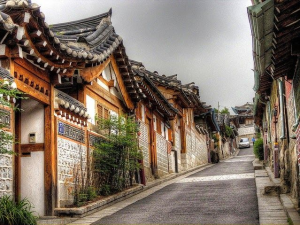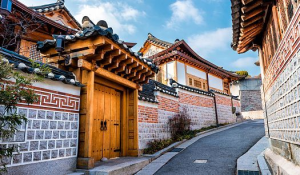Bukchon Hanok Village
Nestled amidst the bustling metropolis of Seoul, South Korea, lies the enchanting Bukchon Hanok Village. This historic neighbourhood is a living testament to the country’s rich cultural heritage and architectural legacy. In this article, we’ll embark on a journey to discover the allure of Bukchon Hanok Village, exploring its traditional hanok houses, cultural significance, and the immersive experience it offers to visitors.
Unveiling the Past: What is Bukchon Hanok Village?
A Glimpse into History
Bukchon Hanok Village dates back to the Joseon Dynasty, spanning over 600 years of history. The name “Bukchon” translates to “northern village,” and it’s strategically positioned between two of Seoul’s most prominent landmarks: Gyeongbokgung Palace and Changdeokgung Palace. Also, read about Eight Wonders of the World
The Hanok Houses
At the heart of Bukchon lies its collection of hanok houses—traditional Korean homes made of wood and clay. These houses showcase exquisite craftsmanship and intricate designs, featuring curved roofs, wooden lattice windows, and elegant courtyards. The village is a living museum where visitors can step back in time and experience the architectural elegance of bygone eras.
https://www.youtube.com/watch?v=Vyaoehjf6rg&pp=ygUVYnVrY2hvbiBoYW5vayB2aWxsYWdl
Immersing in Cultural Delights
Preserving Tradition
Bukchon Hanok Village is not merely a cluster of historic houses; it’s a dedicated effort to preserve Korean cultural heritage. As you stroll along its narrow alleyways, you’ll find art galleries, craft workshops, and tea houses that celebrate traditional arts and crafts.
Hands-On Workshops
Visitors have the unique opportunity to engage in hands-on workshops, learning traditional crafts like calligraphy, pottery, and hanbok (Korean traditional clothing) making. These experiences provide insight into the meticulous craftsmanship that has been passed down through generations.
A Tapestry of Modern and Traditional
Bukchon Hanok Village seamlessly blends the old with the new, offering a juxtaposition of traditional architecture against a backdrop of modernity. This harmonious coexistence is a testament to South Korea’s ability to honour its roots while embracing progress.
Cafes and Boutiques
The village is dotted with charming cafes, boutiques, and guesthouses, each offering a unique perspective on contemporary Korean culture. Visitors can savor local delicacies, purchase handmade crafts, and experience the warm hospitality of the locals.
Exploring Bukchon: Tips and Recommendations
Best Times to Visit
To fully appreciate Bukchon’s beauty, visit during spring when cherry blossoms bloom or in autumn when the village is painted in a myriad of vibrant colours. Weekdays are less crowded, allowing for more intimate exploration.
Getting Lost in the Alleys
One of the village’s charms is its labyrinthine alleys that beckon visitors to explore. Getting lost in these alleys can lead to delightful surprises, from hidden courtyards to panoramic views of the city.

The Journey of Senses
Culinary Delights
Hanok Eateries: A Gastronomic Sojourn
Bukchon Hanok Village is not just a treat for the eyes; it’s also a culinary haven. The village boasts an array of hanok restaurants where visitors can savour authentic Korean cuisine in an ambience that transports them back in time. Discover more about Best Countries to Visit in October | World Tour
Tea Culture: Sip and Savor
Tea enthusiasts will find solace in the village’s teahouses, where they can indulge in the art of tea-making and enjoy serene moments amidst the lush surroundings.
Preservation and Modernization
Bukchon’s preservation efforts are commendable, showcasing a delicate balance between maintaining historical authenticity and embracing modernity. This coexistence makes it an exceptional place where the past and the present intertwine harmoniously.
Seasonal Magic in Bukchon
Each season paints Bukchon with a different palette of colours, making every visit a unique experience. Whether it’s the cherry blossoms of spring or the snow-covered hanok roofs in winter, the village’s beauty adapts to the changing seasons.
A Step Back in Time: Hanok Stay
For a truly immersive experience, some Hanok houses offer stays for visitors. This allows guests to live like locals, sleeping on traditional heated floors (ondol) and waking up to the gentle rustling of nearby trees.
Strolling Through Bukchon’s Alleys
Getting lost in the maze-like alleys of Bukchon is a delightful adventure. Every turn presents a new view, a hidden courtyard, or a glimpse of local life, adding an element of surprise to your exploration.
Bukchon’s Influence on Pop Culture
Bukchon has become a favourite shooting location for films, dramas, and even music videos. Its photogenic streets have contributed to its popularity, making it an iconic backdrop for various forms of media.
Getting Lost in the Charm
Beyond its architectural and cultural significance, Bukchon has an intangible charm that enchants visitors. It’s a place where time seems to slow down, inviting you to savour every moment and appreciate the beauty of simplicity.

Conclusion
Bukchon Hanok Village is a treasure trove of history, culture, and architectural marvels. It serves as a bridge between the past and the present, inviting visitors to connect with Korea’s rich heritage. Whether you’re a history enthusiast, an art lover, or simply someone seeking an authentic experience, Bukchon promises an unforgettable journey through time.
FAQs
Is Bukchon Hanok Village free to enter?
Yes, the village is open to the public and free to enter. Some attractions and workshops may have separate fees.
Can I stay overnight in Bukchon Hanok Village?
Yes, there are guesthouses in the village that offer a unique hanok stay experience.
Are there guided tours available?
Yes, guided tours are available for those who want a more in-depth understanding of the village’s history and significance.
How do I get to Bukchon Hanok Village using public transportation?
You can take the subway or bus to Anguk Station and walk for about 10 minutes to reach the village.
Are there any restrictions for photography?
While photography is generally allowed, some privately owned hanok houses may have restrictions, so it’s best to ask for permission before taking photos.
